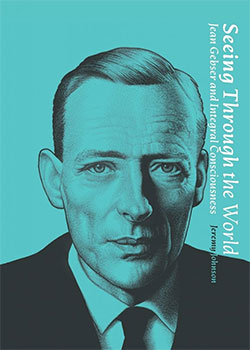 Cynthia Bourgeault continues her series of reflections upon Integral structures of consciousness and ideas brought forth in Jean Gebser’s book, Ever Present Origin (EPO). See below for related resources and links to prior posts.
Cynthia Bourgeault continues her series of reflections upon Integral structures of consciousness and ideas brought forth in Jean Gebser’s book, Ever Present Origin (EPO). See below for related resources and links to prior posts.
In all honesty it must be stated that what little Gebser knew of Gurdjieff he spoke of most disparagingly. In his entire 562-page tome, his comments are confined to a single sweeping back-of-the hand aimed primarily at Gurdjieff’s chief interlocutor, P.D. Ouspensky:
“[Ouspensky’s] interpretation [of the fourth dimension]…is surely the most bizarre possible form of mythical-mental deficiency. It is further confused by his emphasis on “ecstasy,” and the author’s devotion to the magical attitude of his shaman-like teacher, George Gurdjieff, “master” of the “’School of Fontainebleau.’” (EPO, p. 351)
If only Gebser had looked further! While he indeed may be correct in his assessment of Ouspensky’s partial seduction by “ecstasy,” he fails to distinguish that this issue was in fact one of the chief breaking points between Gurdjieff himself and his celebrated pupil. Had Gebser encountered this “shaman-like teacher” first hand, he might well have recognized that, decidedly au contraire, it was Gurdjieff’s rejection of ecstasy that forges a solid common ground between these two G’s and leads me to the perhaps outrageous proposition I will shortly be setting forth: that the Gurdjieff teaching, particularly in its practical disciplines, offers the most compatible and effective overall methodology for “installing” the Integral structure of consciousness as one’s default operating system.
The term “ecstasy” comes from the Greek ec-stasis, “standing outside of oneself.” Its opposite is “ENSTASY,” a term I first encountered in Valentin Tomberg’s profound discussion of the subject in Meditations on the Tarot (pp. 309-311). It means centering in oneself: becoming fiercely, alertly coiled within one’s own “I Am” presence, such that one becomes a center of gravitation in one’s own right. (Incidentally, I believe that Teilhard is pointing toward this same quality when he speaks of centration.) Rather than seeking to transcend or outrun that core sense of personal selfhood in order to dissolve in the infinite, one instead hunkers down in that very self-center and within its finite lineaments encounters in concentrated form that same infinite plenitude of being. Rather than the drop dissolving in the ocean, the ocean fully instantiates in the drop.
What part of intensification do you not understand? This is the bush that burns but is not consumed. This the Theotokos, an image I introduced a few posts ago as the icon par excellence of Gebserian enstasy: Originary Presence shining forth diaphanously from a finite womb.
What makes Gebser’s vision so uniquely compelling— and so quintessentially Western— is his insistence that the Integral structure of consciousness is by nature enstatic rather than ecstatic—and hence, that the way to get there is along a path that deepens intensification rather than simply dissolving boundaries. As he states unequivocally (EPO, 131): “Everything depends on an intensification, not an expansion or extension of consciousness.” And this, in turn, depends on the continued maturation of a conscious self-center (Gebser calls it a “conscious ego”) that can cognize, receive, and bear forth this luminous presence without being immolated by it.
In one of his most pointed discussions of this point he writes:
“The identical deed that prompts Christ to accept suffering via his conscious ego, leads, in Buddhism, to the negation of suffering and the dissolution of the ego, which, transformed, returns to the original state of immaterial Nirvana. In Buddhism, the suspension of sorrow and suffering is to be achieved by turning away from the world. For Christianity the goal is to accept the ego, and the acceptance of sorrow and suffering is to be achieved by loving the world. Thus, the perilous and difficult path which the West must follow is here prefigured…..” (EPO, p. 90)
And in perhaps the boldest comment in his book, slipped in nearly undetected on page 138, he writes:
“It is the originary presence that has itself attained consciousness because one of its bearers, man, has undergone the spatio-temporally conditioned unfolding of consciousness…”
!!!!!!
If truth be told, however, it may be an oversimplification to divide the field so tidily between East and West. There is ecstasy enough to go around in the West as well: plenty of siren calls to lay down the burden of conscious selfhood and dissolve into the infinite, often cloaked in the lofty language of “surrender” and “not my will but thine be done, O Lord.” Teilhard struggled against that siren call all his life. And I confess that I still ride the edge of it often in Centering Prayer, where it takes an intentional exercise of presence not to simply float off into the infinite. It is so much easier, more intoxicating, to “lose oneself”—particularly if this “self” has already been straw-manned as “sinful self-will” and its surrender equated with the threshold of sanctity.
And yes, I admit it’s sometimes a burden—even an imposition—to shift gears into the Gurdjieff practices, where all escape routes are cut off by the implacable demand for continuously renewed presence. Gurdjieff’s “contemplation-like” exercises are hard work, particularly compared to the gentle relaxation of contemplative prayer or charismatic devotion, and the burden of my conscious selfhood often weighs heavily on me, like a snail shell I am somehow obliged to carry always with me on my back. But that’s Gurdjieff for you: it’s enstasy all the way. It’s his signature energy, the most striking hallmark of his Fourth Way path.
This enstatic center of gravity in the Gurdjieff teaching is perhaps best captured in a celebrated exchange between Gurdjieff and his student Olgivanna Lloyd-Wright. When Olgivanna told him that she had a feeling of going out of herself when she gazed at the majestic mountains, Gurdjieff said to her words to the effect of: “Never allow that. Always maintain yourself.” The emphasis throughout the Work—in the exercises, the movements, the teaching, the practical work, the overall rhythm of the day—is to strengthen a capacity known as “doubled” (or “divided” attention), grounded in a fully embodied centrifugal presence, that will allow one to be simultaneously present to multiple demands unfolding in a single instance of “now.”
In other words, The Gurdjieff Work is for all intents and purposes bootcamp for that rigorous intensification of presence that is both prerequisite and first fruit of the emerging Integral structure of consciousness. It delivers the practical training package that gradually deepens the capacity to stay put and deliver the goods in the face of the extraordinary invitation that Gebser lays before us.
Enstasy is the metaphysical tie-rod that holds these “two G’s” together, and why I believe the fit is actually better than with many of the excellent embodiment practices that several of you have brought forward, principally from the Asian traditions, in response to my earlier post. It is the common—and yes, perhaps intrinsically Western—understanding of the aim, of finitude itself, of the holy necessity of constraint, that gives these two superficially incongruous teachings a deep and dynamic resonance: a path one can actually begin to walk… toward a destination one can actually begin to grasp.
*****
If you’re new to Gebser’s revelatory ideas, Cynthia recommends starting with Seeing Through the World: Jean Gebster and Integral Consciousness, by Jeremy Johnson, available at Amazon.com or Revelore Press.
You can helpful commentary and instruction on some of the Gurdjieff practices in Cynthia’s MYSTICAL COURAGE: Commentaries on Selected Contemplative Exercises by G.I. Gurdjieff, as Compiled by Joseph Azize. Learn more here.



Thank you for your deep dive into Gebser. I’m part of the body of Christ practicing out of All Souls Episcopal Church in Berkeley. After our recent Adult Formation classes on Christian heresies, I thought I’d better take a deeper look at the meaning of gnosis. Which in turn led me to The Ever-Present Origin, and to the word “enstacy”, which I googled and found your explanation. I have and have read two of your earlier works and was impressed by what I read coming from an Episcopal priest. Well done. Is there available a compost work on your understanding of Gebser, or must I print out your prior and subsequent posts? Thank you for what you’re doing!